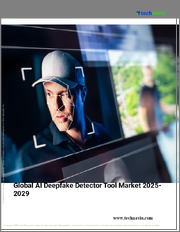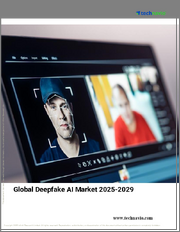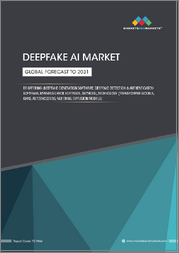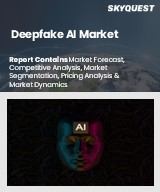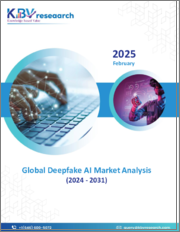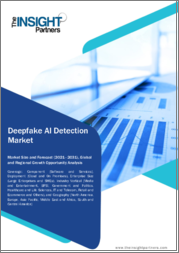
|
시장보고서
상품코드
1662641
딥페이크 AI 시장 예측(-2030년) : 구성요소별, 유형별, 검출 방법별, 전개 방식별, 기술별, 용도별, 지역별 세계 분석Deepfake AI Market Forecasts to 2030 - Global Analysis By Component (Software and Service), Type, Detection Methods, Deployment Mode, Technology, Application and By Geography |
||||||
Stratistics MRC에 따르면, 세계 딥페이크 AI 시장은 2024년 8억 761만 달러로 예측 기간 동안 43.5%의 CAGR로 2030년에는 70억 5,208만 달러에 달할 것으로 예측됩니다.
딥페이크 AI란 인공지능, 특히 GAN(Generative Adversarial Networks)과 같은 딥러닝 기법을 사용하여 사진, 동영상, 음성 등의 초현실적인 가공물을 만드는 것을 일컫는 용어입니다. 딥페이크 기술을 통해 진짜처럼 보이지만 완전히 가짜인 컨텐츠를 생성할 수 있게 되어 자주 가짜 정보를 전달하거나 누군가를 사칭할 수 있게 됩니다. 딥페이크 기술은 교육이나 엔터테인먼트에 활용되고 있지만, 보안이나 프라이버시, 허위 정보 캠페인이나 사기와 같은 악의적인 행위에 악용될 가능성 등 도덕적 문제도 제기되고 있습니다.
AI와 머신러닝의 발전
머신러닝과 인공지능의 발전은 딥페이크 AI 시장을 견인하는 큰 요인으로, 딥페이크 제작의 효율성, 현실성, 정확성을 크게 향상시키고 있습니다. 방대한 양의 데이터로부터 학습을 통해 자동 인코더와 GAN(Generative Adversarial Networks) 등의 기술은 기계가 놀랍도록 사실적인 사진, 영상, 음성을 생성할 수 있게 해줍니다. 딥페이크는 마케팅, 엔터테인먼트, 가상 체험 등의 산업에서 점점 더 많이 활용되고 있는데, 이는 이러한 알고리즘이 현실의 정보에 잘 녹아들 수 있기 때문입니다. 또한, 기계 학습 모델은 지속적으로 개선되고 있으며, 인간의 특징과 행동을 정확하게 모방하는 것이 점점 더 쉬워지고 있습니다.
프라이버시 및 보안 위험
딥페이크 AI 비즈니스는 사람의 목소리, 외모, 행동을 모방한 가짜 컨텐츠를 만드는 데 기술이 사용될 수 있기 때문에 프라이버시와 보안에 심각한 문제를 야기할 수 있습니다. 적대적인 행위자가 다양한 해로운 목적으로 딥페이크를 사용하게 되면 개인정보 도용, 금전적 사기, 명예훼손 등이 발생할 수 있습니다. 또한, 딥페이크 기술은 개인의 초상화를 허가 없이 사용할 수 있게 하여 개인의 프라이버시를 위험에 빠뜨릴 수 있습니다. 딥페이크는 조작, 협박, 허위 정보의 가능성이 높아지기 때문에 더 현실적이 될수록 심각한 보안 위험을 초래할 수 있습니다. 이러한 위협에 대비하여 사람들의 신원 확인과 데이터를 보호하기 위해 딥페이크 탐지 시스템, 법적 안전장치, 프라이버시 법제 등 강력한 대책이 요구되고 있습니다.
가상현실(VR) 및 게임 분야에서의 채택 확대
딥페이크 기술을 통해 개발자는 아바타나 캐릭터 모델에 사실적인 표정, 제스처, 목소리로 확대하여 매우 사실적이고 몰입감 있는 가상 환경을 만들 수 있습니다. 이 기술은 캐릭터를 실제 인물과 유사하게 만들거나 완전히 새로운 가상 페르소나를 생성하여 보다 개인화된 게임 경험을 가능하게 하며, VR 애플리케이션에서는 딥페이크를 사용하여 훈련 환경, 인터랙티브 시뮬레이션, 실제 시나리오를 시뮬레이션하는 등 다양한 용도로 활용될 수 있습니다. 현실적인 시나리오를 시뮬레이션 할 수 있습니다. 사실적이고 인터랙티브한 가상 세계에 대한 수요가 증가함에 따라, 딥페이크 AI를 VR과 게임에 통합함으로써 사용자 참여를 높이고 차세대 경험을 창출할 수 있는 흥미로운 기회를 제공할 수 있습니다.
위험에 대한 소비자 인식이 제한적
스푸핑, 허위 정보, 정보 조작 등 딥페이크가 초래할 수 있는 위험은 많은 사람들에게 잘 알려져 있지 않습니다. 고객들은 딥페이크 기술이 놀랍도록 사실적이지만 완전히 가짜 자료를 만들어내는 능력으로 인해 야기되는 심각한 프라이버시 및 보안 위협을 충분히 인식하지 못하고 있을 수 있습니다. 이러한 무지는 부주의로 인한 가짜 정보의 확산으로 이어져 사람들의 평판을 훼손하고, 여론에 영향을 미치고, 선거에 영향을 미칠 수 있습니다. 딥페이크가 초래하는 위험을 줄이기 위해서는 가짜 미디어를 구별하는 방법, 그 윤리적 영향의 가능성, 기술을 현명하게 사용하는 것의 가치에 대해 일반 대중을 교육하는 것이 필수적입니다.
COVID-19의 영향
COVID-19 사태는 딥페이크 AI 시장에 다양한 영향을 미쳤습니다. 한편으로는 디지털 미디어와 원격 커뮤니케이션에 대한 의존도가 높아지면서 가상 회의, 엔터테인먼트, 교육을 위해 딥페이크를 포함한 AI 기반 컨텐츠 제작의 활용이 가속화되었습니다. 다른 한편으로는 오보, 특히 팬데믹 상황에서 가짜 뉴스의 확산에 대한 우려로 인해 딥페이크 기술의 잠재적 위험에 대한 인식이 높아졌습니다. 이에 따라 딥페이크 탐지 도구의 개발과 윤리적 가이드라인의 확립에 더욱 집중하게 되었습니다.
예측 기간 동안 소프트웨어 부문이 가장 클 것으로 예상됩니다.
예측 기간 동안 소프트웨어 부문이 가장 큰 시장 점유율을 차지할 것으로 예상되며, AI 기반 딥페이크 소프트웨어는 GAN(Generative Adversarial Networks) 및 머신러닝과 같은 기술을 활용하여 매우 사실적인 가짜 이미지, 동영상, 음성을 쉽게 생성할 수 있습니다. 쉽게 만들 수 있습니다. 이러한 도구는 전문가와 소비자 모두에게 점점 더 쉽게 접근이 가능해지고 있으며, 컨텐츠 제작자, 마케팅 담당자, 엔터테인먼트 산업이 몰입감 있는 경험을 만들어낼 수 있게 해줍니다. 소프트웨어가 더욱 정교하고 사용자 친화적으로 발전함에 따라 미디어, 광고, 게임 등의 분야에서 널리 채택되어 딥페이크 AI 시장의 성장을 촉진하고 있습니다.
예측 기간 동안 사이버 보안 부문이 가장 높은 CAGR을 기록할 것으로 예상됩니다.
예측 기간 동안 사이버 보안 부문은 딥페이크 기술의 부상이 디지털 보안에 심각한 위협이 될 것으로 예상됨에 따라 가장 높은 성장률을 보일 것으로 예상됩니다. 딥페이크는 스푸핑, 사기, 소셜 엔지니어링 공격에 활용될 수 있어 강력한 사이버 보안 대책이 필수적입니다. 딥페이크가 점점 더 설득력을 얻으면서 기업, 정부 및 개인은 딥페이크의 악의적인 사용을 식별하고 방지하기 위해 AI 기반 탐지 도구에 투자하고 있습니다. 이러한 보안 솔루션에 대한 수요 증가는 딥페이크 탐지 기술 개발을 촉진하고 사이버 보안 부문의 시장 개척을 촉진하고 있습니다.
가장 큰 점유율을 차지하는 지역
예측 기간 동안 아시아태평양은 급속한 기술 발전, 디지털 컨텐츠 소비 증가, 다양한 산업에서의 AI 도입 증가로 인해 가장 큰 시장 점유율을 차지할 것으로 예상됩니다. 중국, 일본, 한국과 같은 국가들은 AI 연구를 주도하고 있으며, 딥페이크 기술 개발을 가속화하고 있습니다. 또한, 이 지역의 게임, 엔터테인먼트, 미디어 부문의 부상으로 몰입형 컨텐츠에 대한 수요가 증가하고 있습니다. 또한, 딥페이크의 위험에 대응하기 위한 사이버 보안 솔루션에 대한 수요가 증가하면서 이 지역의 시장 성장을 촉진하고 있습니다.
CAGR이 가장 높은 지역
예측 기간 동안 북미는 특히 미국과 캐나다에서 AI 및 머신러닝 기술의 발전으로 인해 가장 높은 CAGR을 보일 것으로 예상됩니다. 이 지역은 엔터테인먼트, 미디어, 게임 산업에서 강력한 입지를 확보하고 있으며, 이는 실감형 디지털 컨텐츠와 가상 경험에 대한 수요를 촉진하고 있습니다. 또한, 광고, 가상 인플루언서, 교육 분야에서 딥페이크 AI의 활용이 증가하고 있는 것도 시장 성장을 가속화하고 있습니다. 이 지역은 또한 딥페이크 위협을 탐지하고 대응하기 위한 사이버 보안 솔루션에 많은 투자를 하고 있으며, 이는 관련 기술의 혁신과 채택을 더욱 촉진하고 있습니다.
무료 커스터마이징 제공
본 보고서를 구독하는 고객은 다음과 같은 무료 맞춤화 옵션 중 하나를 이용할 수 있습니다.
- 기업 소개
- 추가 시장 진입 기업의 종합적인 프로파일링(최대 3개사까지)
- 주요 기업 SWOT 분석(3개사까지)
- 지역 세분화
- 고객의 관심에 따른 주요 국가별 시장 추정 및 예측, CAGR(주: 타당성 검토에 따른)
- 경쟁사 벤치마킹
- 제품 포트폴리오, 지리적 입지, 전략적 제휴를 통한 주요 기업 벤치마킹
목차
제1장 주요 요약
제2장 서문
- 개요
- 이해관계자
- 조사 범위
- 조사 방법
- 데이터 마이닝
- 데이터 분석
- 데이터 검증
- 조사 접근법
- 조사 정보 출처
- 1차 조사 정보 출처
- 2차 조사 정보 출처
- 가정
제3장 시장 동향 분석
- 소개
- 성장 촉진요인
- 성장 억제요인
- 기회
- 위협
- 기술 분석
- 용도 분석
- 신흥 시장
- COVID-19의 영향
제4장 Porter's Five Forces 분석
- 공급 기업의 교섭력
- 구매자의 교섭력
- 대체품의 위협
- 신규 참여업체의 위협
- 경쟁 기업 간의 경쟁 관계
제5장 세계의 딥페이크 AI 시장 : 구성요소별
- 소개
- 소프트웨어
- 서비스
제6장 세계의 딥페이크 AI 시장 : 유형별
- 소개
- 영상 딥페이크
- 오디오 딥페이크
- 비디오 딥페이크
- 텍스트 딥페이크
제7장 세계의 딥페이크 AI 시장 : 검출 방법별
- 소개
- 딥페이크 검출 솔루션
- 블록체인 기반 솔루션
제8장 세계의 딥페이크 AI 시장 : 전개 방식별
- 소개
- 클라우드 기반
- 온프레미스
제9장 세계의 딥페이크 AI 시장 : 기술별
- 소개
- 생성적 적대 네트워크(GAN)
- 오토인코더
- 리커런트 신경망(RNN)
- 변혁 모델
- 자연어 처리(NLP)
- 확산 모델
- 기타
제10장 세계의 딥페이크 AI 시장 : 용도별
- 소개
- 소셜 미디어
- 엔터테인먼트와 미디어
- 사이버 보안
- 마케팅과 광고
- 의료
- E-Commerce
- 기타
제11장 세계의 딥페이크 AI 시장 : 지역별
- 소개
- 북미
- 미국
- 캐나다
- 멕시코
- 유럽
- 독일
- 영국
- 이탈리아
- 프랑스
- 스페인
- 기타 유럽
- 아시아태평양
- 일본
- 중국
- 인도
- 호주
- 뉴질랜드
- 한국
- 기타 아시아태평양
- 남미
- 아르헨티나
- 브라질
- 칠레
- 기타 남미
- 중동 및 아프리카
- 사우디아라비아
- 아랍에미리트
- 카타르
- 남아프리카공화국
- 기타 중동 및 아프리카
제12장 주요 개발
- 계약, 파트너십, 협업, 합작투자
- 인수와 합병
- 신제품 발매
- 사업 확대
- 기타 주요 전략
제13장 기업 개요
- Attestiv Inc.
- Amazon Web Services
- Deepware A.S.
- D-ID
- Google LLC
- iDenfyTM
- Intel Corporation
- Kairos AR, Inc.
- Microsoft
- Oz Forensics
- Reality Defender Inc.
- Resemble AI
- Sensity AI
- Truepic
- WeVerify
According to Stratistics MRC, the Global Deepfake AI Market is accounted for $807.61 million in 2024 and is expected to reach $7052.08 million by 2030 growing at a CAGR of 43.5% during the forecast period. Deepfake AI is the term used to describe the creation of hyper-realistic manipulated material, such as photos, movies, and audio, using artificial intelligence, specifically deep learning methods like Generative Adversarial Networks (GANs). It makes possible to create content that looks real but is completely fake, frequently to distribute false information or impersonate someone. Although deepfake technology has uses in education and entertainment, it also brings up moral questions about security, privacy, and the possibility of abuse in nefarious endeavors like disinformation campaigns and fraud.
Market Dynamics:
Driver:
Advancements in AI and machine learning
Machine learning and artificial intelligence developments are major factors propelling the deepfake AI market, greatly improving the efficiency, realism, and accuracy of deepfake production. By learning from enormous volumes of data, technologies such as auto encoders and Generative Adversarial Networks (GANs) allow machines to produce incredibly realistic photos, movies, and audio. Deepfakes are being used more and more in industries like marketing, entertainment, and virtual experiences as these algorithms get better at blending in with real information. Furthermore, machine learning models are always improving, making it easier for them to accurately mimic human characteristics and behavior.
Restraint:
Privacy and security risks
The deepfake AI business presents serious privacy and security issues since the technology may be used to create fake content that replicates a person's voice, look, or behavior. As a result of hostile actors using deepfakes for a variety of detrimental objectives, this can result in identity theft, financial fraud, and reputational injury. Furthermore, deepfake technology makes it possible for someone's likeness to be used without permission, endangering personal privacy. Deepfakes provide significant security risks as they get more realistic because of the increased potential for manipulation, extortion, and false information. Strong countermeasures, including deepfake detection systems, legal safeguards, and privacy legislation, are required in light of this expanding threat in order to protect people's identities and data.
Opportunity:
Increased adoption in virtual reality (VR) and gaming
Deepfake technology allows developers to create highly realistic and immersive virtual environments by enhancing avatars and character models with lifelike facial expressions, gestures, and voices. This technology enables a more personalized gaming experience by tailoring characters to resemble real-life individuals or creating entirely new virtual personas. In VR applications, deepfakes can be used to simulate realistic scenarios, such as training environments or interactive simulations. As the demand for realistic and interactive virtual worlds grows, the integration of deepfake AI into VR and gaming offers exciting opportunities for enhancing user engagement and creating next-generation experiences.
Threat:
Limited consumer awareness of risks
The possible risks of deepfakes, including identity theft, disinformation, and manipulation, are not well known to many people. Customers could fail to be fully aware of the serious privacy and security threats posed by deepfake technology's capacity to produce incredibly realistic but wholly fake material. This ignorance can result in the inadvertent dissemination of false information, harming people's reputations, affecting public opinion, or even influencing elections. In order to reduce the risks posed by deepfakes, it is imperative that the public be educated on how to spot fake media, its possible ethical ramifications, and the value of employing technology sensibly.
Covid-19 Impact
The COVID-19 pandemic had a mixed impact on the deepfake AI market. On one hand, the increased reliance on digital media and remote communication accelerated the use of AI-driven content creation, including deepfakes, for virtual meetings, entertainment, and education. On the other hand, concerns about misinformation, particularly regarding the spread of fake news during the pandemic, raised awareness about the potential risks of deepfake technology. This led to a greater focus on developing deepfake detection tools and establishing ethical guidelines.
The software segment is expected to be the largest during the forecast period
The software segment is expected to account for the largest market share during the forecast period. AI-powered deepfake software, leveraging technologies like Generative Adversarial Networks (GANs) and machine learning, enables the creation of highly realistic fake images, videos, and audio with ease. These tools are increasingly accessible to both professionals and consumers, enabling content creators, marketers, and entertainment industries to produce immersive experiences. As software becomes more sophisticated and user-friendly, its widespread adoption across sectors like media, advertising, and gaming continues to fuel the growth of the deepfake AI market.
The cybersecurity segment is expected to have the highest CAGR during the forecast period
Over the forecast period, the cybersecurity segment is predicted to witness the highest growth rate, as the rise of deepfake technology poses significant threats to digital security. Deepfakes can be used for identity theft, fraud, and social engineering attacks, making robust cybersecurity measures essential. As deepfakes become more convincing, businesses, governments, and individuals are investing in AI-driven detection tools to identify and prevent malicious use of deepfakes. This growing need for security solutions fuels the development of deepfake detection technologies and promotes market growth in the cybersecurity sector.
Region with largest share:
During the forecast period, Asia Pacific region is expected to hold the largest market share, fuelled by, rapid technological advancements, growing digital content consumption, and increasing adoption of AI across various industries. Countries like China, Japan, and South Korea are leading in AI research, which accelerates the development of deepfake technology. Additionally, the rise of gaming, entertainment, and media sectors in the region boosts the demand for immersive content. Furthermore, the growing need for cybersecurity solutions to combat the risks of deepfakes is propelling market growth in the region.
Region with highest CAGR:
During the forecast period, the North America region is anticipated to exhibit the highest CAGR, driven by advancements in AI and machine learning technologies, particularly in the United States and Canada. The region's strong presence in the entertainment, media, and gaming industries fuels the demand for realistic digital content and virtual experiences. Additionally, the increasing use of deepfake AI in advertising, virtual influencers, and education accelerates market growth. The region also invests heavily in cybersecurity solutions to detect and counter deepfake threats, further driving innovation and adoption of related technologies.
Key players in the market
Some of the key players profiled in the Deepfake AI Market include Attestiv Inc., Amazon Web Services, Deepware A.S., D-ID, Google LLC, iDenfyTM, Intel Corporation, Kairos AR, Inc., Microsoft, Oz Forensics, Reality Defender Inc., Resemble AI, Sensity AI, Truepic, and WeVerify,
Key Developments:
In April 2024, Microsoft showcased its latest AI model, VASA-1, which can generate lifelike talking, faces from a single static image and an audio clip. This model is designed to exhibit appealing visual affective skills (VAS), enhancing the realism of digital avatars.
In March 2024, BiolD launched an updated version of its deepfake detection software, focusing on securing biometric authentication and digital identity verification. This software is designed to prevent identity spoofing by detecting manipulated images and videos and providing real-time analysis and feedback.
In January 2024, In May 2024, Google LLC introduced a new feature in its SynthID tool that allows for the labeling of AI-generated text without altering the content itself. This enhancement builds on SynthID's existing capabilities to identify AI-generated images and audio clips, now incorporating additional information into the large language model (LLM) during text generation.
Components Covered:
- Software
- Service
Types Covered:
- Image Deepfake
- Audio Deepfake
- Video Deepfake
- Text Deepfakes
Detection Methods Covered:
- Deepfake Detection Solutions
- Blockchain-Based Solutions
Deployment Modes Covered:
- Cloud-Based
- On-Premise
Technologies Covered:
- Generative Adversarial Networks (GANs)
- Auto encoders
- Recurrent Neural Networks (RNNs)
- Transformative Models
- Natural Language Processing (NLP)
- Diffusion Models
- Other Technologies
Applications Covered:
- Social Media
- Entertainment & Media
- Cyber security
- Marketing & Advertising
- Healthcare
- E- Commerce
- Other Applications
Regions Covered:
- North America
- US
- Canada
- Mexico
- Europe
- Germany
- UK
- Italy
- France
- Spain
- Rest of Europe
- Asia Pacific
- Japan
- China
- India
- Australia
- New Zealand
- South Korea
- Rest of Asia Pacific
- South America
- Argentina
- Brazil
- Chile
- Rest of South America
- Middle East & Africa
- Saudi Arabia
- UAE
- Qatar
- South Africa
- Rest of Middle East & Africa
What our report offers:
- Market share assessments for the regional and country-level segments
- Strategic recommendations for the new entrants
- Covers Market data for the years 2022, 2023, 2024, 2026, and 2030
- Market Trends (Drivers, Constraints, Opportunities, Threats, Challenges, Investment Opportunities, and recommendations)
- Strategic recommendations in key business segments based on the market estimations
- Competitive landscaping mapping the key common trends
- Company profiling with detailed strategies, financials, and recent developments
- Supply chain trends mapping the latest technological advancements
Free Customization Offerings:
All the customers of this report will be entitled to receive one of the following free customization options:
- Company Profiling
- Comprehensive profiling of additional market players (up to 3)
- SWOT Analysis of key players (up to 3)
- Regional Segmentation
- Market estimations, Forecasts and CAGR of any prominent country as per the client's interest (Note: Depends on feasibility check)
- Competitive Benchmarking
- Benchmarking of key players based on product portfolio, geographical presence, and strategic alliances
Table of Contents
1 Executive Summary
2 Preface
- 2.1 Abstract
- 2.2 Stake Holders
- 2.3 Research Scope
- 2.4 Research Methodology
- 2.4.1 Data Mining
- 2.4.2 Data Analysis
- 2.4.3 Data Validation
- 2.4.4 Research Approach
- 2.5 Research Sources
- 2.5.1 Primary Research Sources
- 2.5.2 Secondary Research Sources
- 2.5.3 Assumptions
3 Market Trend Analysis
- 3.1 Introduction
- 3.2 Drivers
- 3.3 Restraints
- 3.4 Opportunities
- 3.5 Threats
- 3.6 Technology Analysis
- 3.7 Application Analysis
- 3.8 Emerging Markets
- 3.9 Impact of Covid-19
4 Porters Five Force Analysis
- 4.1 Bargaining power of suppliers
- 4.2 Bargaining power of buyers
- 4.3 Threat of substitutes
- 4.4 Threat of new entrants
- 4.5 Competitive rivalry
5 Global Deepfake AI Market, By Component
- 5.1 Introduction
- 5.2 Software
- 5.3 Service
6 Global Deepfake AI Market, By Type
- 6.1 Introduction
- 6.2 Image Deepfake
- 6.3 Audio Deepfake
- 6.4 Video Deepfake
- 6.5 Text Deepfakes
7 Global Deepfake AI Market, By Detection Methods
- 7.1 Introduction
- 7.2 Deepfake Detection Solutions
- 7.3 Blockchain-Based Solutions
8 Global Deepfake AI Market, By Deployment Mode
- 8.1 Introduction
- 8.2 Cloud-Based
- 8.3 On-Premise
9 Global Deepfake AI Market, By Technology
- 9.1 Introduction
- 9.2 Generative Adversarial Networks (GANs)
- 9.3 Autoencoders
- 9.4 Recurrent Neural Networks (RNNs)
- 9.5 Transformative Models
- 9.6 Natural Language Processing (NLP)
- 9.7 Diffusion Models
- 9.8 Other Technologies
10 Global Deepfake AI Market, By Application
- 10.1 Introduction
- 10.2 Social Media
- 10.3 Entertainment & Media
- 10.4 Cybersecurity
- 10.5 Marketing & Advertising
- 10.6 Healthcare
- 10.7 E- Commerce
- 10.8 Other Applications
11 Global Deepfake AI Market, By Geography
- 11.1 Introduction
- 11.2 North America
- 11.2.1 US
- 11.2.2 Canada
- 11.2.3 Mexico
- 11.3 Europe
- 11.3.1 Germany
- 11.3.2 UK
- 11.3.3 Italy
- 11.3.4 France
- 11.3.5 Spain
- 11.3.6 Rest of Europe
- 11.4 Asia Pacific
- 11.4.1 Japan
- 11.4.2 China
- 11.4.3 India
- 11.4.4 Australia
- 11.4.5 New Zealand
- 11.4.6 South Korea
- 11.4.7 Rest of Asia Pacific
- 11.5 South America
- 11.5.1 Argentina
- 11.5.2 Brazil
- 11.5.3 Chile
- 11.5.4 Rest of South America
- 11.6 Middle East & Africa
- 11.6.1 Saudi Arabia
- 11.6.2 UAE
- 11.6.3 Qatar
- 11.6.4 South Africa
- 11.6.5 Rest of Middle East & Africa
12 Key Developments
- 12.1 Agreements, Partnerships, Collaborations and Joint Ventures
- 12.2 Acquisitions & Mergers
- 12.3 New Product Launch
- 12.4 Expansions
- 12.5 Other Key Strategies
13 Company Profiling
- 13.1 Attestiv Inc.
- 13.2 Amazon Web Services
- 13.3 Deepware A.S.
- 13.4 D-ID
- 13.5 Google LLC
- 13.6 iDenfyTM
- 13.7 Intel Corporation
- 13.8 Kairos AR, Inc.
- 13.9 Microsoft
- 13.10 Oz Forensics
- 13.11 Reality Defender Inc.
- 13.12 Resemble AI
- 13.13 Sensity AI
- 13.14 Truepic
- 13.15 WeVerify









